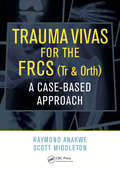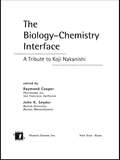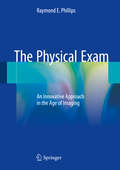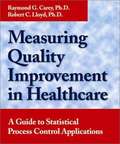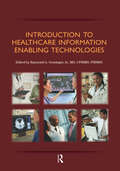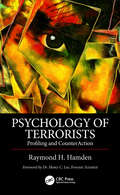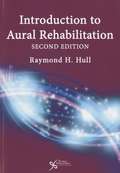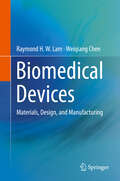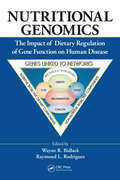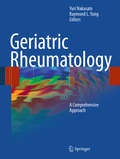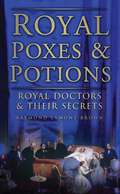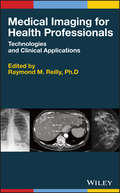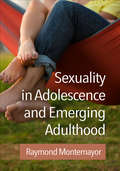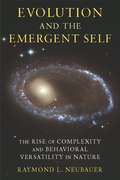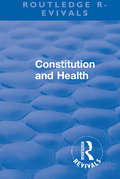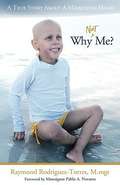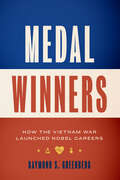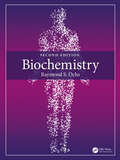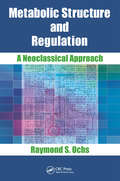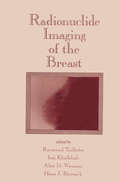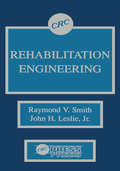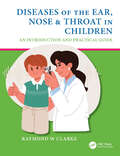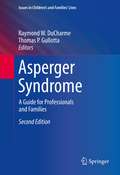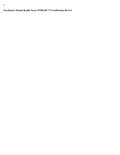- Table View
- List View
Trauma Vivas for the FRCS: A Case-Based Approach
by Raymond Anakwe Scott MiddletonThis new book is targeted at higher trainees in orthopaedic surgery preparing for the second part of the FRCS (Tr & Orth) exam. The exam involves a set of vivas during which a range of topics is discussed, the aim being to demonstrate trauma safety and competence rather than trauma expertise. Examiners may use props such as models, clinical pictures, clinical studies, and x-rays to introduce topics and initiate discussion. This book uses a similar model to allow the candidate to practise key topics for discussion with common presentations and histories, and high quality x-rays. The book lends itself to individual and small group learning as trainees prepare for their examinations.
The Biology - Chemistry Interface: A Tribute To Koji Nakanishi
by Raymond CooperA tribute to the pioneering scientific work of Professor Koji Nakanishi, whose studies of natural products have effaced some of the conventional boundaries between biology and chemistry. It discusses an array of chromatographic separation methods and determination of structures on a microscale, analyzes bioassay-directed fractionation and other means of isolating biologically active compounds from plants and other sources, covers vital enzymes isolated from marine organisms such as algae, and more.
The Physical Exam
by Raymond E. PhillipsThis book invites clinicians to take a fresh look at the routine physical examination by outlining in detail how they can adapt a more efficient, regional approach to the exam activity. By adopting the systematic sequence and focus provided in this novel title, clinicians can offer a more modern physical examination, one that may prove more productive than the methods taught in the pre-imaging era. The Physical Exam: An Innovative Approach in the Age of Imaging offers a unique, step-by-step sequence for the physical exam. The text guides the clinician through a series of steps that involve observing, touching and listening - in an organized sequence, region by region - of all organ systems. The general approach is applicable to every physical examination and can be modified when appropriate. Express pathways are provided so that the clinicians can quickly assess the general health of the patient while focusing on the presenting problem. A major contribution to the diagnostic literature, the book offers a format and level of complexity that will be of significant value to internal medicine and family physicians, emergency professionals, nurse practitioners, physician's assistants, and medical students.
Measuring Quality Improvement In Healthcare: A Guide To Statistical Process Control Applications
by Raymond G. Carey Robert C. LloydThis ground-breaking book addresses the critical, growing need among health care administrators and practitioners to measure the effectiveness of quality improvement efforts. Written by respected healthcare quality professionals, Measuring Quality Improvement in Healthcare covers practical applications of the tools and techniques of statistical process control (SPC), including control charts, in healthcare settings. The authors' straightforward discussions of data collection, variation, and process improvement set the context for the use and interpretation of control charts. Their approach incorporates "the voice of the customer" as a key element driving the improvement processes and outcomes. The core of the book is a set of 12 case studies that show how to apply statistical thinking to health care process, and when and how to use different types of control charts. The practical, down-to-earth orientation of the book makes it accessible to a wide readership.
Introduction to Healthcare Information: Enabling Technologies (HIMSS Book Series)
by Raymond GensingerIntroduction to Health Care Management is a concise, reader-friendly, introductory healthcare management book that covers a wide variety of healthcare settings, from hospitals to nursing homes and clinics. Filled with examples to engage the reader's imagination, the important issues in healthcare management, such as ethics, cost management, strategic planning and marketing, information technology, and human resources, are all thoroughly covered. Guidelines and rubrics along with numerous case studies make this text both student-friendly and teacher friendly. It is the perfect resource for students of healthcare management, nursing, allied health, business administration, pharmacy, occupational therapy, public administration, and public health.
Psychology of Terrorists: Profiling and CounterAction
by Raymond H. HamdenThe Psychology of Terrorists examines the personality profile of the individual and categorizes the psychology of terrorists into four distinct profiles which are outlined and analyzed in detail. There are many books that cover social psychology and political violence and aggression, but few establish the mind-set of the terrorist as an individual. This includes taking into account personal experiences, and religious or political ideology for the purposes of understanding conceptual and tactical objectives and profiling terrorists to counter terrorist threats. <P><P>Dr. Raymond Hamden presents a unique look at terrorists as individuals with personal motives as well as those of principle. The book presents an analysis of terrorists without prejudice or bias for any political, religious, nationality, creed, or race. Too many times the world see experts focus on issues that are based on their own predispositions or partialities. Although there is criticism on the reliability of profiling, this research demonstrates validity and reliability. It is vital to understand terrorist motivations and this can only be achieved by "knowing" the terrorists' psychological character, looking at the individual terrorist, taking into account particular experiences, psychological makeup, background, and fundamentalist ideology. <P><P>The Psychology of Terrorists: Profiling and CounterAction will be a welcomed addition to psychologists, terrorism researchers, criminal profilers, investigators and intelligence professionals, counter- and anti-terrorism experts, as well as military, security, and law enforcement professionals tasked with protecting individuals from the various acts of terrorism, domestically and globally.
Introduction to Aural Rehabilitation (Second Edition)
by Raymond H. HullNow in its second edition, Introduction to Aural Rehabilitation continues to provide all the elements necessary for a comprehensive, practice-oriented course in the habilitation/rehabilitation of children, adults, and the elderly with impaired hearing. This user-friendly text focuses on the most important clinical and practical aspects of providing services to the hearing impaired, while avoiding the technical detail of theoretical texts. . This second edition offers more in-depth information on cochlear implantation-including surgical procedures as well as the benefits for children and adults-and is approached from an amplification standpoint across several chapters by new contributing authors. . New and expanded information for Introduction to Aural Rehabilitation, Second Edition, includes the following topics: Speech development for children with impaired hearing; Listening and language development for children with impaired hearing; Hearing aids and non-hearing aid assistive listening devices; Hearing aids for children with impaired hearing; Educational management of children with impaired hearing; Non-hearing assistive listening devices for adults; Physiology and psycho-social impact of hearing loss in older adulthood; Rehabilitation procedures for adults with impaired hearing; and Expanded appendixes on communication scales and questionnaires
Biomedical Devices: Materials, Design, and Manufacturing
by Weiqiang Chen Raymond H. LamThis textbook provides essential knowledge for biomedical product development, including material properties, fabrication processes and design techniques for different applications, as well as process design and optimization. This book is multidisciplinary and readers can learn techniques to apply acquired knowledge for various applications of biomedical design. Further, this book encourages readers to discover and convert newly reported technologies into products and services for the future development of biomedical applications. This is an ideal book for upper-level undergraduate and graduate students, engineers, technologists, and researchers working in the area of biomedical engineering and manufacturing.This book also:Provides a comprehensive set of fundamental knowledge for engineering students and entry level engineers to design biomedical devicesOffers a unique approach to manufacturing of biomedical devices by integrating and formulating different considerations in process design tasks into optimization problemsProvides a broad range of application examples to guide readers through the thinking process of designing and manufacturing biomedical devices, from basic understanding about the requirements and regulations to a set of manufacturing parameters
Nutritional Genomics: The Impact of Dietary Regulation of Gene Function on Human Disease
by Raymond L. Rodriguez Wayne R. BidlackThe notion of matching diet with an individual's genetic makeup is transforming the way the public views nutrition as a means of managing health and preventing disease. To fulfill the promise of nutritional genomics, researchers are beginning to reconcile the diverse properties of dietary factors with our current knowledge of genome structure and g
Geriatric Rheumatology
by Yuri Nakasato Raymond L. YungThe first book dedicated explicitly to the care of elderly patients with rheumatic diseases, this comprehensive resource is a practical guide for navigating the medical concerns of these complex patients. While patients over 65 years of age comprise roughly 15% of the population, they consume about 50% of rheumatology resources. This book presents current clinical practices with an eye toward achieving economically sustainable models of care. The world's leading authorities have come together to cover the full spectrum of rheumatic diseases, the immune system in aging, and ultrasound evaluation and arthrocentesis. The book also addresses the milieu of co-morbidities that the clinician may encounter with an older patient, as well as the accompanying concerns about multiple pharmacologic therapies and drug interactions. Bringing in experts from a wide array of subspecialties, the editors present the essentials of multidisciplinary care, an approach which is the hallmark of geriatrics and which naturally translates into the field of gerontorheumatology. Designed for primary care physicians and rheumatology consultants, Geriatric Rheumatology is an invaluable guide to caring for this rapidly growing patient population.
Royal Poxes and Potions: Royal Doctors and Their Secrets
by Raymond Lamont-BrownRoyal Poxes and Potions is a fascinating look at the relationship between monarchs and their doctors and reveals the complex and influential position that they held. Acclaimed biographer Raymond Lamont Brown casts light on a previously overlooked aspect of the monarchy and the secrets it conceals. From the instigation of the royal doctor in medieval times and up to the present day, the tales of secrets, murder, medical incompetence and revolutionary operations make compelling reading. Included here is Sir William Gull, court physician to Queen Victoria, who was a suspect in the Jack the Ripper case, and Sir Frederick Treves, who was not only court physician to the four succeeding monarchs, but was also the man who helped to rescue the Elephant Man, Joseph Merrick, from a fairground freak show.
Medical Imaging for Health Professionals: Technologies and Clinical Applications
by Raymond M. ReillyDescribes the most common imaging technologies and their diagnostic applications so that pharmacists and other health professionals, as well as imaging researchers, can understand and interpret medical imaging science This book guides pharmacists and other health professionals and researchers to understand and interpret medical imaging. Divided into two sections, it covers both fundamental principles and clinical applications. It describes the most common imaging technologies and their use to diagnose diseases. In addition, the authors introduce the emerging role of molecular imaging including PET in the diagnosis of cancer and to assess the effectiveness of cancer treatments. The book features many illustrations and discusses many patient case examples. Medical Imaging for Health Professionals: Technologies and Clinical Applications offers in-depth chapters explaining the basic principles of: X-Ray, CT, and Mammography Technology; Nuclear Medicine Imaging Technology; Radionuclide Production and Radiopharmaceuticals; Magnetic Resonance Imaging (MRI) Technology; and Ultrasound Imaging Technology. It also provides chapters written by expert radiologists in well-explained terminology discussing clinical applications including: Cardiac Imaging; Lung Imaging; Breast Imaging; Endocrine Gland Imaging; Abdominal Imaging; Genitourinary Tract Imaging; Imaging of the Head, Neck, Spine and Brain; Musculoskeletal Imaging; and Molecular Imaging with Positron Emission Tomography (PET). Teaches pharmacists, health professionals, and researchers the basics of medical imaging technology Introduces all of the customary imaging tools—X-ray, CT, ultrasound, MRI, SPECT, and PET—and describes their diagnostic applications Explains how molecular imaging aids in cancer diagnosis and in assessing the effectiveness of cancer treatments Includes many case examples of imaging applications for diagnosing common diseases Medical Imaging for Health Professionals: Technologies and Clinical Applications is an important resource for pharmacists, nurses, physiotherapists, respiratory therapists, occupational therapists, radiological or nuclear medicine technologists, health physicists, radiotherapists, as well as researchers in the imaging field.
Sexuality in Adolescence and Emerging Adulthood
by Raymond MontemayorWritten in an engaging question-and-answer format, this accessible text synthesizes contemporary empirical research to provide a panoramic view of adolescent sexual development and behavior. The book examines sexuality as part of normative growth and development, in addition to addressing traditional problem areas such as sexual risk taking. Candid personal stories bring the theory and research to life. Topics include the precursors of adolescent sexuality in childhood; biological aspects of adolescent sexuality, including puberty and the adolescent brain; the influences of parents, peers, and the media; and gender and racial/ethnic differences in attitudes and behavior. Coverage also encompasses romantic relationships; the experiences of sexual- and gender-minority youth; sexually transmitted infections; contraception, pregnancy, and teen parenthood; cross-cultural and international research; and approaches to sex education. Pedagogical Features *Headings written as questions throughout the chapters--for example, "How common is hooking up?" and "Is coming out to parents always a good thing?" *"In Their Own Words" boxes with firsthand accounts from adolescents and young adults. *"Focus on Research" sidebars that discuss research methods, challenges, and controversies in the field. *End-of-chapter summaries and suggested readings.
Evolution and the Emergent Self: The Rise of Complexity and Behavioral Versatility in Nature
by Raymond NeubauerEvolution and the Emergent Self is an eloquent and evocative new synthesis that explores how the human species emerged from the cosmic dust. Lucidly presenting ideas about the rise of complexity in our genetic, neuronal, ecological, and ultimately cosmological settings, the author takes readers on a provocative tour of modern science's quest to understand our place in nature and in our universe. Readers fascinated with "Big History" and drawn to examine big ideas will be challenged and enthralled by Raymond L. Neubauer's ambitious narrative.How did humans emerge from the cosmos and the pre-biotic Earth, and what mechanisms of biological, chemical, and physical sciences drove this increasingly complex process? Neubauer presents a view of nature that describes the rising complexity of life in terms of increasing information content, first in genes and then in brains. The evolution of the nervous system expanded the capacity of organisms to store information, making learning possible. In key chapters, the author portrays four species with high brain:body ratios—chimpanzees, elephants, ravens, and dolphins—showing how each species shares with humans the capacity for complex communication, elaborate social relationships, flexible behavior, tool use, and powers of abstraction. A large brain can have a hierarchical arrangement of circuits that facilitates higher levels of abstraction.Neubauer describes this constellation of qualities as an emergent self, arguing that self-awareness is nascent in several species besides humans and that potential human characteristics are embedded in the evolutionary process and have emerged repeatedly in a variety of lineages on our planet. He ultimately demonstrates that human culture is not a unique offshoot of a language-specialized primate, but an analogue of fundamental mechanisms that organisms have used since the beginning of life on Earth to gather and process information in order to buffer themselves from fluctuations in the environment.Neubauer also views these developments in a cosmic setting, detailing open thermodynamic systems that grow more complex as the energy flowing through them increases. Similar processes of increasing complexity can be found in the "self-organizing" structures of both living and nonliving forms. Recent evidence from astronomy indicates that planet formation may be nearly as frequent as star formation. Since life makes use of the elements commonly seeded into space by burning and expiring stars, it is reasonable to speculate that the evolution of life and intelligence that happened on our planet may be found across the universe.
Revival: Constitution And Health (1933) (Routledge Revivals)
by Raymond PearlThe material in this book is an expansion of a lecture given at the Army Medical Center, Washington, D.C., on May 15, 1933. I have thought it best to leave it in the somewhat informal discourse of the lecture platform. References to the literature, and other annotations, are numbered consecutively and placed together at the end of the book. It should be pointed out here at the start, as it is in the text, that the author is not a medical man, but merely a biologist greatly interested in human biology; aware of his deficiencies in knowledge and experience consequent upon not having an equally lively sense of his inalienable right as a biologist to study man, the most interesting of all animals.
Why Not Me?: A True Story about a Miracle in Miami
by Raymond Rodriguez-TorresWhy Not Me? describes, in a very inspirational tone, how Raymond believes there is a divine purpose for everything. Raymond is an executive who dedicates his free time to helping cancer families and others to live lives of purpose, balance & victory. He holds the title of Sir. Knight in the Knights of Columbus and enjoys giving back to his community. He lives in Miami with his daughters and his wife Shannah.
Medal Winners: How the Vietnam War Launched Nobel Careers
by Raymond S. GreenbergAs the ground war in Vietnam escalated in the late 1960s, the US government leveraged the so-called doctor draft to secure adequate numbers of medical personnel in the armed forces. Among newly minted physicians’ few alternatives to military service was the Clinical Associate Training Program at the National Institutes of Health. Though only a small percentage of applicants were accepted, the elite program launched an unprecedented number of remarkable scientific careers that would revolutionize medicine at the end of the twentieth century. Medal Winners recounts this overlooked chapter and unforeseen byproduct of the Vietnam War through the lives of four former NIH clinical associates who would go on to become Nobel laureates. Raymond S. Greenberg traces their stories from their pre-NIH years and apprenticeships through their subsequent Nobel Prize–winning work, which transformed treatment of heart disease, cancer, and other diseases. Greenberg shows how the Vietnam draft unintentionally ushered in a golden era of research by bringing talented young physicians under the tutelage of leading scientists and offers a lesson in what it may take to replicate such a towering center of scientific innovation as the NIH in the 1960s and 1970s.
Medal Winners: How the Vietnam War Launched Nobel Careers
by Raymond S. GreenbergAs the ground war in Vietnam escalated in the late 1960s, the US government leveraged the so-called doctor draft to secure adequate numbers of medical personnel in the armed forces. Among newly minted physicians’ few alternatives to military service was the Clinical Associate Training Program at the National Institutes of Health. Though only a small percentage of applicants were accepted, the elite program launched an unprecedented number of remarkable scientific careers that would revolutionize medicine at the end of the twentieth century. Medal Winners recounts this overlooked chapter and unforeseen byproduct of the Vietnam War through the lives of four former NIH clinical associates who would go on to become Nobel laureates. Raymond S. Greenberg traces their stories from their pre-NIH years and apprenticeships through their subsequent Nobel Prize–winning work, which transformed treatment of heart disease, cancer, and other diseases. Greenberg shows how the Vietnam draft unintentionally ushered in a golden era of research by bringing talented young physicians under the tutelage of leading scientists and offers a lesson in what it may take to replicate such a towering center of scientific innovation as the NIH in the 1960s and 1970s.
Biochemistry
by Raymond S. OchsBiochemistry Second Edition, is a single-semester text designed for undergraduate non-biochemistry majors. Accessible, engaging, and informative, it is the perfect introduction to the subject for students who may approach chemistry with apprehension. Its unique emphasis on metabolism and its kinetic underpinnings gives the text up-to-the-minute relevance for students investigating current public health concerns, such as obesity and diabetes. Biochemistry Second Edition will encourage students to explore the basics of chemistry and its influence on biological problems. Key Features: Provides an understanding of (mostly) enzymatic reactions that are responsible for the function and maintenance of living things. This innovative text for non-biochemistry majors includes introductory material at the beginning of each chapter that contextualizes chapter themes in real-life scenarios. Online supporting materials with further opportunities for research and investigation. Synthesis questions at the end of each chapter that encourage students to make connections between concepts and ideas, as well as develop critical-thinking skills. About the Author: Raymond S. Ochs is a biochemist with a career-long specialty in metabolism spanning 30 years. Previously, he has written the textbook Biochemistry, contributed the metabolism chapters to another text, Principles of Biochemistry, and co-edited a collection of articles published as Metabolic Regulation, and the recent monograph Metabolic Strucure and Regulation. His research interests concern major pathways of liver and muscle, including glycolysis, gluconeogenesis, ureogenesis, fatty acid metabolism, glycogen metabolism, and control by cAMP, Ca2+, diacylglycerol, and AMPK. He is currently professor of pharmacy at St. John’s University in New York, teaching biochemistry, physiology, and medicinal chemistry.
Metabolic Structure and Regulation: A Neoclassical Approach
by Raymond S. OchsThere is a renewed interest in the fundamentals of energy metabolism, yet most people base their understanding on the views of generalists expressed in elementary textbooks. New techniques that enable analysis of thousands of metabolites provide useful data, but do not themselves substitute for an understanding of the fundamentals of metabolism. While classical ideas of metabolism are also valuable, some earlier ideas have not withstood further investigation. This book presents a personal philosophy but rests on what is broadly accepted by metabolic biochemists over the past few decades.
Radionuclide Imaging of the Breast
by Raymond TailleferDemonstrating the role of nuclear medicine as a complementary technique to mammography and other imaging modalities for the diagnosis of breast cancer, Radionuclide Imaging of the Breast provides a comprehensive overview of scintimammography-an accurate, safe, and noninvasive imaging method for the evaluation of breast lesions and malignancies. Reveals the encouraging results of multicenter clinical trials in the U.S. and Canada using 99mTc sestamibi breast imaging for the diagnosis of primary breast carcinoma! Addressing nonsurgical sampling of nonpalpable breast lesions as an effective means of providing diagnostic and prognostic information, Radionuclide Imaging of the Breastdiscusses increasing the diagnostic value of mammography and its widespread use examines the reliability of FDG-PET and FDG-SPECT in detecting lymph node involvement and distant metastases reviews breast cancer imaging with monoclonal antibodies, including murine and bioengineered antibodies compares the benefits and limitations of Thallium-20l to 99mTc-sestamibi breast imaging in evaluating suspected malignancy assesses the clinical impact of scintimammography as an adjunctive test to mammography to improve the dependability of diagnoses considers the possibility of replacing axillary lymph node dissection in patients with small breast cancers with the sentinel node approach clarifies the importance of surgery in the multimodality treatment of breast cancer elucidates pathologic difficulties for breast cancer diagnosis and more! Radionuclide Imaging of the Breast serves as an essential reference for nuclear medicine physicians, radiologists, breast surgeons, medical and surgical oncologists, gynecologists, pathologists, internists, and primary care physicians.
Rehabilitation Engineering
by Raymond V. SmithThe purpose of this handbook is to bring together information on the special devices and associated systems which have been developed to assist the handicapped in living and vocational pursuits and in clinical use. This unique work places emphasis on the devices and systems plus includes sufficient background information to clarify the objectives and use. The general subject matter is divided into two major areas. The first area deals primarily with the environment of the handicapped. The second section deals with devices for personal assist systems-such as for testing, evaluation, and training-and devices which provide individualized support. The information in this comprehensive handbook will assist those working directly in the broad field of rehabilitation of the handicapped and also those associated with the subject matter in a peripheral way, including counseling and vocational evaluation.
Diseases of the Ear, Nose & Throat in Children: An Introduction and Practical Guide
by Raymond W ClarkeAn essential introduction to the clinical examination, treatment and surgical procedures for children with diseases of the ear, nose and throat. This book encompasses the conditions most commonly encountered in the emergency setting, on the ward and in the outpatient clinic.With its highly practical approach and step-by-step guidance,this book will be invaluable for all surgical trainees studying for higher postgraduate examinations in ENT, as well as an essential guide for otorhinolaryngologists, primary care practitioners and specialist ENT nurses in the early years of training.
Asperger Syndrome: A Guide for Professionals and Families (Issues in Children's and Families' Lives #3)
by Thomas P. Gullotta Raymond W. DucharmeSince the first edition was published in 2003, an enormous amount of research into Asperger Syndrome (AS) and autism spectrum disorders has been conducted. New genetic and epigenetic theories, updated findings on viable therapies, and targeted skill-building programs provide a solid foundation of information for professionals to use in practice and impart to concerned families. The Second Edition of Asperger Syndrome synthesizes the current state of the field, beginning with the controversy over the proposed linking of the condition with autism in the DSM-5. This comprehensive guide gives readers a deeper understanding of the disorder, detailing the effective strategies and therapies available to improve the lives of young people with AS and ensure their successful transition from childhood to adolescence to adulthood. Focusing on core deficit and treatment areas, expert contributors analyze the evidence base on behavioral and pharmacological interventions as well as educational strategies geared toward bolstering cognitive and social skills. In addition to epidemiology, etiology, diagnosis, and assessment, this volume offers the most current information on: Counseling and other therapeutic strategies for children with AS and their families.Early intervention for children and youth with AS.Social skills instruction for children with AS.Evaluating evidence-based instruction for children with AS.Comprehensive education-based mental health services for students diagnosed on the autism spectrum.Practical advice for families, from a parent of a child with AS.The Second Edition of Asperger Syndrome is an essential reference for researchers, clinicians, and scientist-practitioners in clinical child, school, and developmental psychology; child and adolescent psychiatry; education; rehabilitation medicine/therapy; social work; and pediatrics.
Psychiatric-Mental Health Nurse (PMH-BC) Certification Review
by Raymond ZakhariPsychiatric-Mental Health Nursing (PMH-BC™) Certification Review is designed to help you prepare for the American Nurses Credentialing Center (ANCC) board certification exam. This comprehensive study aid begins with an overview of the exam, scope and standards of practice, and fundamental theories. It examines topics such as therapeutic treatment and management, patient education, cultural competence, communication, health promotion, and crisis management. A wide range of psychiatric disorders, as organized in the DSM-5, are systematically reviewed in a templated approach that takes the reader through the nursing process step by step. <p><p>Each chapter covers everything you need to know to pass the exam and includes end-of-chapter questions to check your knowledge. The review concludes with a full-length practice test to get you ready for exam day. With over 300 practice questions, detailed review content and answer rationales, and access to ExamPrepConnect, this study aid empowers you with the tools and materials to study your way and the confidence to pass the first time, guaranteed! Know that you're ready. Know that you'll pass with Springer Publishing Exam Prep.
